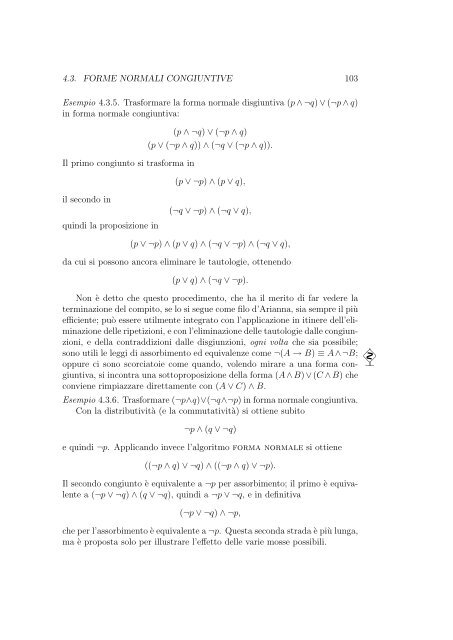Logica Matematica Corso di Laurea in Informatica ... - Mbox.dmi.unict.it
Logica Matematica Corso di Laurea in Informatica ... - Mbox.dmi.unict.it
Logica Matematica Corso di Laurea in Informatica ... - Mbox.dmi.unict.it
You also want an ePaper? Increase the reach of your titles
YUMPU automatically turns print PDFs into web optimized ePapers that Google loves.
4.3. FORME NORMALI CONGIUNTIVE 103<br />
Esempio 4.3.5. Trasformare la forma normale <strong>di</strong>sgiuntiva (p ∧ ¬q) ∨ (¬p ∧ q)<br />
<strong>in</strong> forma normale congiuntiva:<br />
Il primo congiunto si trasforma <strong>in</strong><br />
il secondo <strong>in</strong><br />
qu<strong>in</strong><strong>di</strong> la proposizione <strong>in</strong><br />
(p ∧ ¬q) ∨ (¬p ∧ q)<br />
(p ∨ (¬p ∧ q)) ∧ (¬q ∨ (¬p ∧ q)).<br />
(p ∨ ¬p) ∧ (p ∨ q),<br />
(¬q ∨ ¬p) ∧ (¬q ∨ q),<br />
(p ∨ ¬p) ∧ (p ∨ q) ∧ (¬q ∨ ¬p) ∧ (¬q ∨ q),<br />
da cui si possono ancora elim<strong>in</strong>are le tautologie, ottenendo<br />
(p ∨ q) ∧ (¬q ∨ ¬p).<br />
Non è detto che questo proce<strong>di</strong>mento, che ha il mer<strong>it</strong>o <strong>di</strong> far vedere la<br />
term<strong>in</strong>azione del comp<strong>it</strong>o, se lo si segue come filo d’Arianna, sia sempre il più<br />
efficiente; può essere utilmente <strong>in</strong>tegrato con l’applicazione <strong>in</strong> <strong>it</strong><strong>in</strong>ere dell’elim<strong>in</strong>azione<br />
delle ripetizioni, e con l’elim<strong>in</strong>azione delle tautologie dalle congiunzioni,<br />
e della contrad<strong>di</strong>zioni dalle <strong>di</strong>sgiunzioni, ogni volta che sia possibile;<br />
sono utili le leggi <strong>di</strong> assorbimento ed equivalenze come ¬(A → B) ≡ A ∧ ¬B; <br />
oppure ci sono scorciatoie come quando, volendo mirare a una forma congiuntiva,<br />
si <strong>in</strong>contra una sottoproposizione della forma (A ∧ B) ∨ (C ∧ B) che<br />
conviene rimpiazzare <strong>di</strong>rettamente con (A ∨ C) ∧ B.<br />
Esempio 4.3.6. Trasformare (¬p∧q)∨(¬q∧¬p) <strong>in</strong> forma normale congiuntiva.<br />
Con la <strong>di</strong>stributiv<strong>it</strong>à (e la commutativ<strong>it</strong>à) si ottiene sub<strong>it</strong>o<br />
¬p ∧ (q ∨ ¬q)<br />
e qu<strong>in</strong><strong>di</strong> ¬p. Applicando <strong>in</strong>vece l’algor<strong>it</strong>mo forma normale si ottiene<br />
((¬p ∧ q) ∨ ¬q) ∧ ((¬p ∧ q) ∨ ¬p).<br />
Il secondo congiunto è equivalente a ¬p per assorbimento; il primo è equivalente<br />
a (¬p ∨ ¬q) ∧ (q ∨ ¬q), qu<strong>in</strong><strong>di</strong> a ¬p ∨ ¬q, e <strong>in</strong> def<strong>in</strong><strong>it</strong>iva<br />
(¬p ∨ ¬q) ∧ ¬p,<br />
che per l’assorbimento è equivalente a ¬p. Questa seconda strada è più lunga,<br />
ma è proposta solo per illustrare l’effetto delle varie mosse possibili.




![Introduzione ai sistemi Wiki [PDF] - Mbox.dmi.unict.it](https://img.yumpu.com/16413205/1/184x260/introduzione-ai-sistemi-wiki-pdf-mboxdmiunictit.jpg?quality=85)











